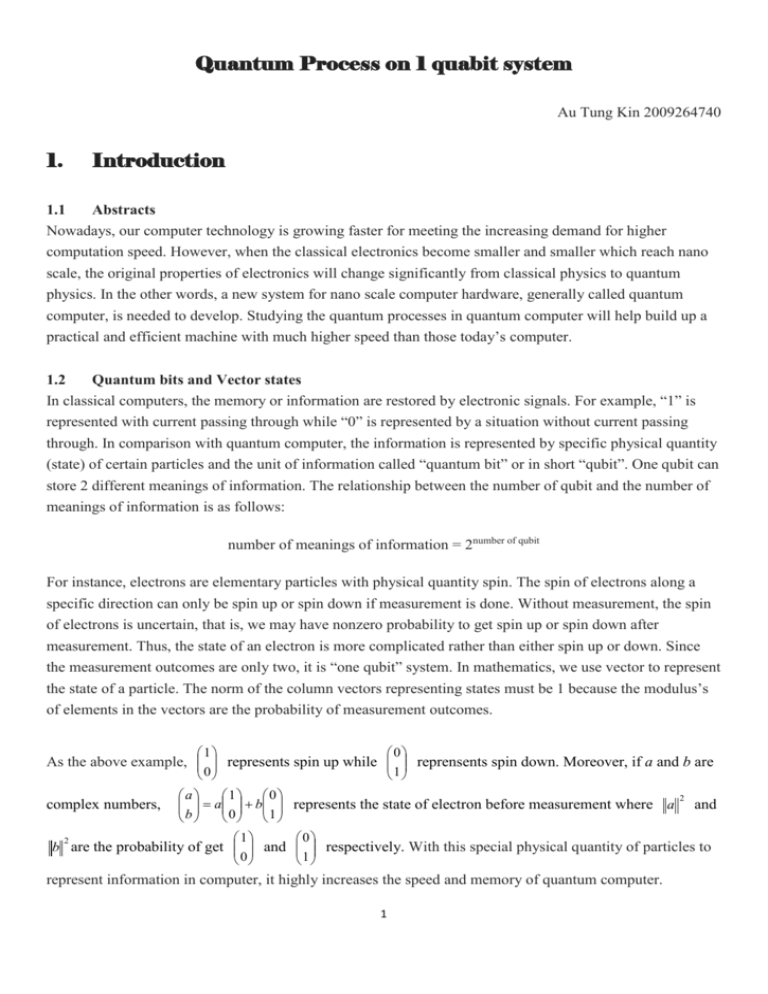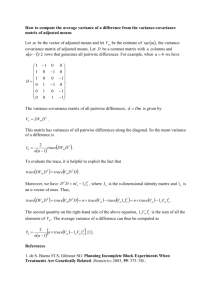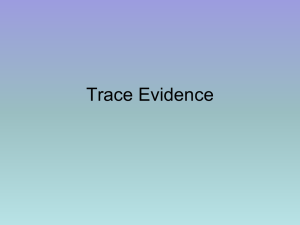Qubit Channels
advertisement

Quantum Process on 1 quabit system
Au Tung Kin 2009264740
1.
Introduction
1.1
Abstracts
Nowadays, our computer technology is growing faster for meeting the increasing demand for higher
computation speed. However, when the classical electronics become smaller and smaller which reach nano
scale, the original properties of electronics will change significantly from classical physics to quantum
physics. In the other words, a new system for nano scale computer hardware, generally called quantum
computer, is needed to develop. Studying the quantum processes in quantum computer will help build up a
practical and efficient machine with much higher speed than those today’s computer.
1.2
Quantum bits and Vector states
In classical computers, the memory or information are restored by electronic signals. For example, “1” is
represented with current passing through while “0” is represented by a situation without current passing
through. In comparison with quantum computer, the information is represented by specific physical quantity
(state) of certain particles and the unit of information called “quantum bit” or in short “qubit”. One qubit can
store 2 different meanings of information. The relationship between the number of qubit and the number of
meanings of information is as follows:
number of meanings of information = 2number of qubit
For instance, electrons are elementary particles with physical quantity spin. The spin of electrons along a
specific direction can only be spin up or spin down if measurement is done. Without measurement, the spin
of electrons is uncertain, that is, we may have nonzero probability to get spin up or spin down after
measurement. Thus, the state of an electron is more complicated rather than either spin up or down. Since
the measurement outcomes are only two, it is “one qubit” system. In mathematics, we use vector to represent
the state of a particle. The norm of the column vectors representing states must be 1 because the modulus’s
of elements in the vectors are the probability of measurement outcomes.
1
0
As the above example, represents spin up while reprensents spin down. Moreover, if a and b are
0
1
complex numbers,
a
1 0
a b represents the state of electron before measurement where
b
0 1
a
2
and
1
0
2
b are the probability of get and respectively. With this special physical quantity of particles to
0
1
represent information in computer, it highly increases the speed and memory of quantum computer.
1
1.3
Quantum process in closed and open systems
1.3.1 Quantum process in closed systems
If the system of physical particles is assumed to be isolated from environment, it is called closed systems.
In such system, the mathematical expression of the state of particles will still be column vector.
After Quantum process acting on a certain state of a particle, the state of the particle will change to a new
one, that is , a new column vector. Quantum process is analogy to a mapping from a vector space V to itself
where the vector space V includes all column vectors corresponding to all states.
Let U be a matrix representation of any quantum process under a certain basis, x and y are the column
vectors representing the initial state and state after U of an electron.
y=Ux
As we mentioned before, the norm of y must be 1, that is
y* y = y y* = 1
(U x)* (U x) = x* U* U x = 1
1 0
.Hence, quantum process is unitary
0 1
Since x is arbitrary, then we have UU* = U*U = I22 where I22 =
similarity transforms.
1.3.2 Quantum process in open systems
If the system is interfered with the environment, it is called open system. In an open system, the
mathematical expression of the state of particles cannot be column vector anymore because we are not
certain about the state of particles. Take the spin of electron as an example: we know the pure state can be
a
b
represented by . However, open system means we do not know exactly the state of particles in this
moment, say, the spin of electron has been measured several times by experimenters before. Instead of
knowing the measurement outcomes of the experimenters, what we only know is the probability of the state
of particles. We can use density matrix, which its trace must be 1 and semi-positive definite, to represent
such uncertain state of particles.
For example, after several measurements of experimenters on the spin of an electron, we know the
2
1
0
probabilities of last measurements and are 0.3 and 0.7 respectively.
0
1
Hence,
1
density matrix = 0.3
0
*
1
0
0.7
0
1
*
1
0
0.3 0
0
= 0.3 1 0 0.7 0 1 =
0
1
0 0.7
1
2.
Transforming 1 quabit system in closed and open system
2.1
Quantum process in closed systems with 1 quabit
Transforming vector states to vector states
We first study the quantum process in closed system, i.e. the state of the system is certain and can be
represented by a 2 × 1 column vector.
Consider unitary transformations pauli-x, -y, -z, we found that acting whatever number of transformations is
the same as acting 2 times. That is, if computer is assigned to undergo astronomical number of times of
transformation, it is inefficient to do such transformation as the results can also be got by undergoing 1 or 2
times transformation. It will save time in computation.
Claim:
1 0
0 1
0
i
1
0
, X
and Z
, Y
.
Let I
0
0 1
i
1 0
0 1
The combination of I, X, Y, and Z under usual matrix multiplication is aI, bX, cY, and dZ where a, b, c and d
can only be 1, 1, i and i.
Proof:
2
0 1
0 1 0 1 1 0
I
X
1 0
1 0 1 0 0 1
2
2
i 0
0 i
i 1 0
I
0 0 1
2
0 1
1 0
0 1 0
I
1 0 1
0
Y
i
i
0
0
i
1
Z
0
0
1
1
0
2
2
Since X2, Y2 and Z2 = I, operating X, Y, or Z consecutively many times on a certain column vector is
equivalent to operating one time of them.
For example, X 3 X 2 X IX X .
In general, we have the following results:
X
Xn
I
if n is odd
if n is even
3
Y
Yn
I
Z
Zn
I
if n is odd
if n is even
if n is odd
if n is even
From the above results, we can exclude the possibility of combination of I, X, Y, and Z under usual matrix
multiplication containing Xl, Ym and Zn where l, m and n are integers without loss of generosity.
0 1 0
XY
1 0 i
0
YX
i
i 1
i
0 0
i 0 1
1
i
0 1 0
0
0 1 1
XZ
1 0 0
0
0
i
1
i
0
iZ
1
0
iZ XY
1
i
iY
0
i
iY XZ
0
1
ZX
0
0 0 1 0
i
1 1 0 i
0
YZ
i
i 1
0 0
0 0 1
i
iX
1 1 0
1
ZY
0
0 0
1 i
i
0 1
i
iX YZ
0
1 0
The above shows all the products of any two different X, Y, and Z matrices under multiplications, the
product of any two matrices will become times the remaining matrix where can only be 1 or i.
Also, the product of any two matrix of X, Y, and Z is not commute but anti-commute such as XY = YX.
With the known of multiply X, Y, and Z several times is same as nothing or multiply itself once and product
of any two of X, Y, and Z is a constant of 1 or i multiplying one of X, Y, and Z, hence the combination of I,
X, Y, and Z under usual matrix multiplication is aI, bX, cY, and dZ where a, b, c and d can only be 1, 1, i
and i.
For example, XYZYXZ = I and in general, we have X n1 Y n2 Z n3 X , Y or Z where can only be 1 or
i.
2.2
Quantum process in open systems with 1 quabit
Transforming qubit states represented as 2x2 density matrices
In practical, pure states of system are difficult to appear as the state of system will interfere with the
environment. Hence, in actuality, quantum process deals with acting on a density matrix representing the
mixed states of the system.
4
In quantum process acting on density matrix, we are interested in given elements of density matrices Ai and
Bi , we want to know whether there is a common linear mapping T: H2 2 H2 2 such that T(Ai) = Bi . If so,
what the expression of the linear mapping is. Since the linear mapping represents quantum process, hence
the linear mapping T must also be completely positive and trace preserving. That is the linear mapping T
satisfies conditions of
tr T E11 tr T E22 1
tr T E12 tr T E21 0
where
T ( E11 ) T ( E21 )
T ( E ) T ( E ) is semi - positive definite
12
22
1 0
0 1
0 0
0 0
, E12
, E 21
and E 22
.
E11
0 0
0 0
1 0
0 1
We consider the following 4 situations with linear mapping
tr T E11 tr T E22 1
tr T E12 tr T E21 0
satisfies
:
T ( E11 ) T ( E21 )
T ( E ) T ( E ) is positive semi - definite
12
22
(1) A linear mapping T: H2 2 H2 2 with mapping all density matrices A to a specific density matrix B.
(2) A linear mapping T: H2 2 H2 2 with mapping specific density matrices A1 and A2 to a specific
density matrices B1 and B2 respectively.
(3) A linear mapping T: H2 2 H2 2 with mapping specific density matrices A1, A2 and A3 to a specific
density matrices B1, B2 and B3 respectively.
(4) A linear mapping T: H2 2 H2 2 with mapping specific density matrices A1, A2, A3 and A4 to a
specific density matrices B1, B2, B3 and B4 respectively.
So far, we have done (1) and (4). For (2), we have proved some linear mappings are failed.
2.2.1 Quantum process transforms all density matrices to a specific density matrix
Claim:
1 0
0 1
0 0
0 0
, E12
, E 21
and E 22
. For all 2 2 density matrices A and
0 0
0 0
1 0
0 1
Let E11
given a 2 2 density matrix B, the linear mapping T: H2 2 H2 2 with T(A) = tr(A) B is the unique linear
5
mapping satisfying the following three conditions:
(1)
(2)
(3)
T A B
tr T E11 tr T E22 1
tr T E12 tr T E21 0
T ( E11 ) T ( E21 )
T ( E ) T ( E ) is positive semi - definite
12
22
Proof:
First to check whether the mapping T: H2 2 H2 2 with T(A) = tr(A) B is a linear mapping or not.
Given any 2 2 density matrices A1 and A2, any constant a ,
T(A1 + A2) = tr(A1 + A2) B = tr(A1) B + tr(A2) B = T(A1) + T(A2)
T(aA) = tr(aA) B = a tr(A) B = aT(A)
Hence, the mapping T: H2 2 H2 2 with T(A) = tr(A) B is a linear mapping or not.
Second, it is clearly that for all 2 2 density matrices A and given a 2 2 density matrix B with T(A) = B
satisfied because trace of density matrix must be 1. Hence, condition (1) is satisfied.
Then, consider the image of E11 , E12 , E 21 , E 22 under the mapping T.
T ( E11 ) tr ( E11 ) B B
T ( E12 ) tr ( E12 ) B 0 22
T ( E 21 ) tr ( E 21 ) B 0 22
where 022 is a 2 2 matrix with all elements are zero.
T ( E 22 ) tr ( E 22 ) B B
0 0
= 0.
0 0
Clearly, tr[ T ( E12 ) ] = tr[ T ( E 21 ) ] = tr(022) = tr
Since B is a density matrix, i.e. tr(B) = 1 and B is semi-positive definite,
then tr[ T ( E11 ) ] = tr[ T ( E11 ) ] = tr(B) = 1.
Hence, condition (2) is satisfied.
For condition (3),
T ( E ) T ( E )
B
0
11
21
Choi’s Matrix of T =
= 0 B
T ( E12 ) T ( E 22 )
Since B is a density matrix, i.e. B is semi-positive definite, then let 1 0, 2 0 be eigenvalues of B and the
corresponding eigenvectors with respect to 1, 2 are v1 and v2 respectively where v1 and v2 are 2 1
matrices (i.e. column vectors) i.e. B v1 = 1 v1 and B v2 = 2 v2 .
B
0
0 v1 B v1 1 v1
v
1 1
B 0 0 0
0
6
B
0
0 v 2 B v 2 2 v 2
v
2 2
B 0 0 0
0
0
B 0 0 0 0
0 B v Bv v 1 v
1 1 1 1
1
0
B 0 0 0 0
0 B v Bv v 2 v
2 2 2 2
2
B
0
0
v
1
Thus,
has eigenvalue 1 0 with degree 2 and the corresponding eigenvectors 0 and v ,
0
B
1
v
0
B
0
eigenvalue 2 0 with degree 2 and the corresponding eigenvectors 2 and . Namely,
is
0
0 B
v 2
B
0
semi-positive definite, i.e.
is positive. Hence, condition (3) is satisfied.
0 B
Consider a linear mapping L: H2 2 H2 2 with L(A) = B for all elements of 2 2 density matrix A and a
given specific element of 2 2 density matrix B.
0
i
Since A +
0
i
T(A +
0
T
i
0
T
i
i
0
i
0
i
0
and A +
i
0
0 1
are also 2 2 hermitian density matrices,
1 0
) = B and T(A +
0 1
=
= T
1 0
0 1
=
= T
1 0
0 0
0 0
0 0
0 0
0
i (1) (2) : T E12
0
i (1) (2) : T E 0
21
0
0 1
) = B and T(A) = B
1 0
0 0
(1)
T iE12 iE 21 iT E12 iT E 21
0 0
T E E T E T E 0 0 (2)
12
21
12
21
0 0
0
0
0
0
0 0
is a necessary condition for a linear mapping maps all density
0 0
Hence, T ( E12 ) = T ( E 21 ) = 022 =
matrices to a specific density matrix.
With T ( E11 ) = T ( E11 ) = B,
1 0
0 1
0 0
0 0
, E12
, E 21
, E 22
are fixed.
0 0
0 0
1 0
0 1
the image of basis of M2 2 E11
That is, the linear mapping is fixed since the image of basis are fixed.
7
Hence, the linear mapping T for mapping all density matrices to a specific density matrix is unique and it is
T(A) = tr(A) B.
2.2.2 Quantum process transforms 2 specific density matrices to 2 specific density matrices
Claim: For 2 2 density matrices A1 and A2, 2 2 density matrix B1 and B2, the linear mapping T: H2 2
H2 2 with T1(X) = (B1 B2) (A1 A2)-1[X A1 tr(X)] + B2 tr(X) where X H2 2 and the linear mapping
trT E trT1 E22 1
for i 1, 2 but fail to satisfy condition of 1 11
.
trT1 E12 trT1 E21 0
satisfying the conditions of T1 Ai Bi
Proof:
First to check whether the mapping T1: H2 2 H2 2 with T1 (X) = (B1 B2) (A1 A2)-1[X A1 tr(X)] + B2
tr(X) is a linear mapping or not.
Given any 2 2 density matrices X, X1 and X2, any constant a ,
T1 (X1 + X2)
= (B1 B2) (A1 A2)-1[(X1 + X2) A1 tr(X1 + X2)] + B2 tr(X1 + X2)
= {(B1 B2) (A1 A2)-1[X1 A1 tr(X1)] + B2 tr(X1) }+ {(B1 B2) (A1 A2)-1[X2 A1 tr(X2)] + B2 tr(X2)}
= T1 (X1) + T1 (X2)
T1 (aX)
= (B1 B2) (A1 A2)-1[aX A1 tr(aX)] + B2 tr(aX)
= a{(B1 B2) (A1 A2)-1[X A1 tr(X)] + B2 tr(X)}
= aT1 (X)
Hence, the mapping T1: H2 2 H2 2 with T1 (X) = (B1 B2) (A1 A2)-1[X A1 tr(X)] + B2 tr(X) is a linear
mapping.
trT1 E11 trT1 E22 1
, writing a program to randomly generate
trT1 E12 trT1 E21 0
For checking the failure of condition
some density matrices to determine whether the condition is satisfied or not.
The code of SciLab and one of the corresponding results are as follows:
SciLab Code
E_11 = [1 0 ; 0 0 ] ; E_12 = [0 1; 0 0 ] ; E_21 = [0 0 ; 1 0]; E_22 = [0 0 ; 0 1];
A_1_11 = rand(); A_1_12 = rand() ; A_1_21 = A_1_12; A_1_22 = 1- A_1_11;
A_2_11 = rand(); A_2_12 = rand() ; A_2_21 = A_2_12; A_2_22 = 1- A_2_11;
8
B_1_11 = rand(); B_1_12 = rand() ; B_1_21 = B_1_12; B_1_22 = 1- B_1_11;
B_2_11 = rand(); B_2_12 = rand() ; B_2_21 = B_2_12; B_2_22 = 1- B_2_11;
A_1 = [A_1_11
A_2 = [A_2_11
A_1_12; A_1_21
A_2_12; A_2_21
A_1_22 ];
A_2_22 ];
B_1 = [B_1_11
B_2 = [B_2_11
B_1_12;
B_2_12;
B_1_22 ];
B_2_22 ];
B_1_21
B_2_21
function T = T_1(x)
T = (B_1 - B_2)*inv(A_1-A_2)*(x-A_2*trace(x))+B_2*trace(x);
endfunction
A_1, A_2, B_1, B_2
x_1 = [trace(T_1(E_11)) , trace(T_1(E_12)) , trace(T_1(E_21)) ,
trace(T_1(E_22)) ]
Result
A_1 =
0.2312237
0.2164633
0.2164633
0.7687763
A_2 =
0.8833888
0.6525135
0.6525135
0.1166112
B_1 =
0.3076091
0.9329616
0.9329616
0.6923909
B_2 =
0.2146008
0.312642
0.312642
0.7853992
x_1 = [trace(T_1(E_11)) , trace(T_1(E_12)) , trace(T_1(E_21)) , trace(T_1(E_22)) ]
x_1 =
1. - 0.5914195
0.5914195
1.
9
As tr T1 E12 = - 0.5914195 and trT1 E 21 = 0.5914195 which both is order of 10-1, thus we can exclude the
possibility of round-off error in the computation.
Hence, the following is a counter example to show the linear mapping T1: H2 2 H2 2 with
trT1 E11 trT1 E22 1
.
trT1 E12 trT1 E21 0
T1 (X) = (B1 B2) (A1 A2)-1[X A1 tr(X)] + B2 tr(X) fail to satisfy the condition
i.e. T1 (X) = (B1 B2) (A1 A2)-1[X A1 tr(X)] + B2 tr(X) is not a linear mapping satisfying
(1)
(2)
(3)
T1 Ai Bi
for i 1, 2
tr T1 E11 tr T1 E22 1
tr T1 E12 tr T1 E21 0
.
T1 ( E11 ) T1 ( E21 )
T ( E ) T ( E ) is positive semi - definite
1
22
1 12
Other than the linear mapping T1: H2 2 H2 2 with T1(X) = (B1 B2) (A1 A2)-1[X A2 tr(X)] + B2 tr(X),
there are other linear mapping Ti: H2 2 H2 2 for i = 2, 3 and 4 with
T2(X) = (B1 B2) [X A2 tr(X)] (A1 A2)-1 + B2 tr(X)
T3(X) = (A1 A2)-1 [X A2 tr(X)] (B1 B2) + B2 tr(X)
T4(X) = [X A2 tr(X)] (A1 A2)-1 (B1 B2) + B2 tr(X)
Similarly, Ti: H2 2 H2 2 for i = 2, 3 and 4 all are linear mapping and satisfies T1 Ai Bi
for i 1, 2 .
trTi E11 trTi E22 1
.
trTi E12 trTi E21 0
Using program to check them, they all also fail to satisfies the condition of
The code of SciLab and the corresponding results are as follows:
SciLab Code
E_11 = [1 0 ; 0 0 ] ; E_12 = [0 1; 0 0 ] ; E_21 = [0 0 ; 1 0]; E_22 = [0 0 ; 0 1];
A_1_11 = rand(); A_1_12 = rand() ; A_1_21 = A_1_12; A_1_22 = 1- A_1_11;
A_2_11 = rand(); A_2_12 = rand() ; A_2_21 = A_2_12; A_2_22 = 1- A_2_11;
B_1_11 = rand(); B_1_12 = rand() ; B_1_21 = B_1_12; B_1_22 = 1- B_1_11;
B_2_11 = rand(); B_2_12 = rand() ; B_2_21 = B_2_12; B_2_22 = 1- B_2_11;
A_1 = [A_1_11
A_2 = [A_2_11
A_1_12; A_1_21
A_2_12; A_2_21
A_1_22 ];
A_2_22 ];
B_1 = [B_1_11
B_1_12;
B_1_22 ];
B_1_21
10
B_2 = [B_2_11
B_2_12;
B_2_21
B_2_22 ];
function T = T_2(x)
T = (B_1 - B_2) *(x-A_2*trace(x))*inv(A_1-A_2) +B_2*trace(x);
endfunction
function T = T_3(x)
T = inv(A_1-A_2)*(x-A_2*trace(x))* (B_1 - B_2)+B_2*trace(x);
endfunction
function T = T_4(x)
T = (x-A_2*trace(x))*inv(A_1-A_2) * (B_1 - B_2) +B_2*trace(x);
endfunction
A_1, A_2, B_1, B_2
x_2 = [trace(T_2(E_11)) , trace(T_2(E_12)) , trace(T_2(E_21)) , trace(T_2(E_22)) ]
x_3 = [trace(T_3(E_11)) , trace(T_3(E_12)) , trace(T_3(E_21)) , trace(T_3(E_22)) ]
x_4 = [trace(T_4(E_11)) , trace(T_4(E_12)) , trace(T_4(E_21)) , trace(T_4(E_22)) ]
Results
A_1 =
0.2693125
0.6325745
0.6325745
0.7306875
A_2 =
0.4051954
0.9184708
0.9184708
0.5948046
B_1 =
0.0437334
0.4818509
0.4818509
0.9562666
B_2 =
0.2639556
0.4148104
0.4148104
0.7360444
x_2 = [trace(T_2(E_11)) , trace(T_2(E_12)) , trace(T_2(E_21)) , trace(T_2(E_22)) ]
x_2 =
1.
0.7192589 - 0.7192589
1.
11
x_3 = [trace(T_3(E_11)) , trace(T_3(E_12)) , trace(T_3(E_21)) , trace(T_3(E_22)) ]
x_3 =
1. - 0.7192589
0.7192589
1.
x_4 = [trace(T_4(E_11)) , trace(T_4(E_12)) , trace(T_4(E_21)) , trace(T_4(E_22)) ]
x_4 =
1.
0.7192589 - 0.7192589
1.
For k = 2, 3, 4 and i = 1, 2, since trTk E12 and trTk E 21 are order of 10-1 which is far greater than order
of 10-16.
Hence, the above is also a counter example to show the linear mapping Tk: H2 2 H2 2 with
fail to satisfy the condition trTk E12 trTk E 21 0 .
That is,
(1)
Tk ’s are not linear mappings satisfying (2)
(3)
Tk Ai Bi
tr Tk E11 tr T k E22 1
tr Tk E12 tr Tk E21 0
.
Tk ( E11 ) Tk ( E21 )
T ( E ) T ( E ) is positive semi - definite
k
22
k 12
2.2.3 Quantum process transforms 4 specific density matrices to 4 specific density matrices
For the case of finding a linear mapping T: H2 2 H2 2 such that T(Ai) = Bi for i = 1, 2, 3, 4 for 4 linearly
independent Ai . Since Ai are linearly independent, then the linear mapping T is fixed under the conditions of
T(Ai) = Bi for i = 1, 2, 3, 4. Namely, there is only one linear mapping satisfies T(Ai) = Bi for i = 1, 2, 3, 4 if Ai
are linearly independent. Then checking the linear mapping T fulfils the conditions of
(1)
(2)
(3)
T Ai Bi
for i 1, 2, 3, 4
tr T E11 tr T E22 1
tr T E12 tr T E21 0
T ( E11 ) T ( E21 )
T ( E ) T ( E ) is positive semi - definite
12
22
12








